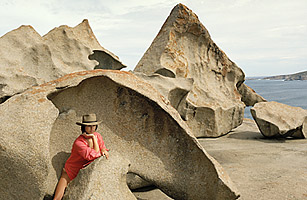
Sylvia Tamburo, of the Southern Ocean Lodge, at Remarkable Rocks on Kangaroo Island, Australia.
Charles Darwin was so surprised by Australia that he suspected it was a separate creation from the rest of the world, and that was after visiting only one of the many astonishing living laboratories of unique flora and fauna and exquisite natural beauty that can be found off the mainland.
Lord Howe Island is a two-hour flight northeast of Sydney on a Dash 8 propeller plane and boasts five species of birds found nowhere else on earth, including a flightless wood hen that is so curious that when you snap your fingers, it scuttles out of the forest to see what's going on. In the turquoise Pacific waters surrounding the island, huge, harmless kingfish — each as big as a small child — might join you for a swim, and sea turtles often paddle past, unruffled. Twelve miles (about 20 km) off the coast, Balls Pyramid rises like a mighty cathedral spire 1,800 ft. (550 m) out of the sea. The rock formation — access to which requires a hard-to-get permit, a mountaineer's climbing skills and serious sea legs for an often rough crossing — is the world's tallest sea stack and the last home on earth of the Lord Howe Island phasmid (Dryococelus australis), a nasty-looking though largely harmless critter that resembles a prawn crossed with a big Havana cigar.
One explanation for the almost Edenic purity of Lord Howe's creatures is that this World Heritage-listed island, which is a little less than 7 miles (11 km) long and at no point more than 1.2 miles (2 km) wide, along with Balls Pyramid (where you can't stay overnight), remained completely undiscovered by European or Polynesian explorers until 1788. No trace of indigenous people has ever been found. Thus the wildlife developed no innate fear of humans. The first settlers didn't move to Lord Howe until 1833 — more than a century after the notion of far-flung islands gathered romance with the publication of Daniel Defoe's Robinson Crusoe — and today fewer than 350 people reside there. Visitors are kept to a minimum, with a cap of 400 at a time, a lucky 20 of whom get to stay at Capella Lodge, an unexpectedly luxurious yet laid-back hideaway. The surfer-chef makes great use of local ingredients (seafood, dairy products and farm-fresh organic fruit and vegetables), accompanied by well-chosen wines freighted in from the mainland.
Think Australia — and certainly travel experts are anticipating that many will do just that once the scorched-earth epic of the same name, starring Nicole Kidman and Hugh Jackman, arrives in multiplexes in November — and you'll most likely visualize the empty outback, majestic Uluru (Ayers Rock) or the sparkling white "sails" of the Sydney Opera House. Less widely known is that this vast island continent is surrounded by what are arguably the most diverse outliers of any country — from coral cays in the Great Barrier Reef to remnant volcanoes in the Pacific. And while most are way too rugged for the casual traveler to access, about a dozen now offer adventurous yet luxurious little-known vacation spots that combine astounding natural landscapes with five-star service and, where applicable, accommodations that are thoughtfully constructed to maximize wildlife-gazing and at the same time deter those infamous spiders and snakes from entering your bed.
The best place to see Australia's almost comical marsupials in the wild is the aptly named Kangaroo Island, off South Australia, which is known to locals as K.I. and to scientists as "Australia's Galápagos" and "the zoo without fences." On a landmass roughly the size of Long Island, N.Y., there are kangaroos, of course, as well as wallabies, bandicoots and koalas, the latter introduced in the 1920s. Each July, K.I. becomes one of the few places in the world to witness an echidna mating train (the echidna, which looks somewhat like a porcupine, is not a marsupial but an egg-laying monotreme), in which up to eight males spend about a month following a single female as she makes up her mind which one will get to father her baby, or puggle. Of course, July is winter in the southern hemisphere, but visitors to K.I. won't feel they are missing out on an ocean experience, since this area is one of the white-shark capitals of the world.